External Fixator Market
External Fixator Market Size and Share Forecast Outlook 2025 to 2035
The external fixator market is projected to grow from USD 2.2 billion in 2025 to USD 3.4 billion by 2035, at a CAGR of 4.4%. Unilateral will dominate with a 40.0% market share, while hospitals will lead the end use segment with a 55.0% share.
External Fixator Market Forecast and Outlook 2025 to 2035
The external fixator market stands at the threshold of a decade-long expansion trajectory that promises to reshape orthopedic surgery technology and trauma treatment solutions. The market's journey from USD 2.2 billion in 2025 to USD 3.4 billion by 2035 represents substantial growth, the market will rise at a CAGR of 4.4% which demonstrating the accelerating adoption of advanced fixation technology and bone stabilization optimization across orthopedic facilities, trauma centers, and ambulatory surgical operations.
The first half of the decade (2025-2030) will witness the market climbing from USD 2.2 billion to approximately USD 2.7 billion, adding USD 0.5 billion in value, which constitutes 41% of the total forecast growth period. This phase will be characterized by the rapid adoption of advanced external fixation systems, driven by increasing orthopedic surgery volumes and the growing need for precision bone stabilization solutions worldwide. Enhanced fixation capabilities and automated alignment systems will become standard expectations rather than premium options.
The latter half (2030-2035) will witness continued growth from USD 2.7 billion to USD 3.4 billion, representing an addition of USD 0.7 billion or 59% of the decade's expansion. This period will be defined by mass market penetration of smart fixation technologies, integration with comprehensive orthopedic management platforms, and seamless compatibility with existing surgical infrastructure.
The market trajectory signals fundamental shifts in how orthopedic facilities approach trauma treatment and bone healing management, with participants positioned to benefit from growing demand across multiple fixator types and surgical segments.
Quick Stats for External Fixator Market
- External Fixator Market Value (2025): USD 2.2 billion
- External Fixator Market Forecast Value (2035): USD 3.4 billion
- External Fixator Market Forecast CAGR: 4.4%
- Leading Product Type in External Fixator Market: Unilateral External Fixators
- Key Growth Regions in External Fixator Market: North America, East Asia, and Western Europe
- Top Players in External Fixator Market: Stryker, Zimmer Biomet, Smith & Nephew, Orthofix, Johnson & Johnson DePuy Synthe
- Where revenue comes from - Now Vs Next (Industry-level view)
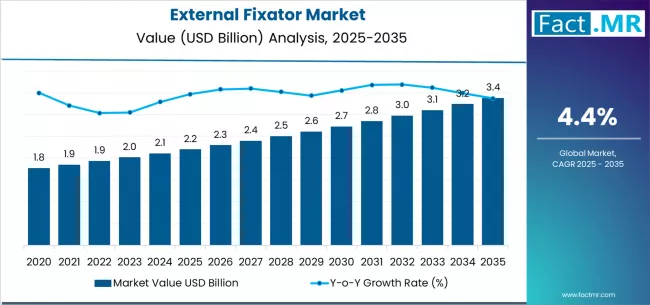
| Period | Primary Revenue Buckets | Share | Notes |
|---|---|---|---|
| Today | New fixator sales (unilateral, circular, hybrid) | 45% | Capital equipment purchases for surgical procedures |
| Components & accessories | 25% | Pins, rods, clamps for system assembly | |
| Service & maintenance contracts | 20% | Technical support, equipment calibration | |
| Training & education services | 10% | Surgeon training, application techniques | |
| Future (3-5 yrs) | Advanced fixation systems | 40-45% | Smart fixators with monitoring integration |
| Digital planning & navigation | 15-20% | 3D planning software, surgical navigation tools | |
| Service-as-a-solution | 15-20% | Comprehensive fixation programs, outcome tracking | |
| Components & consumables | 10-15% | Enhanced pin systems, smart monitoring sensors | |
| Training & certification | 8-12% | Digital education, simulation training programs | |
| Data & analytics services | 5-8% | Treatment outcome analysis, surgical performance metrics |
External Fixator Market Key Takeaways
At-a-Glance Metrics
| Metric | Value |
|---|---|
| Market Value (2025) → | USD 2.2 billion |
| Market Forecast (2035) ↑ | USD 3.4 billion |
| Growth Rate ★ | 4.4% CAGR |
| Leading Product Type → | Unilateral External Fixators |
| Primary Application → | Hospital Segment |
The market demonstrates strong fundamentals with unilateral external fixators capturing a dominant share through advanced stabilization capabilities and orthopedic treatment optimization. Hospital applications drive primary demand, supported by increasing trauma cases and complex fracture treatment requirements. Geographic expansion remains concentrated in developed markets with established orthopedic infrastructure, while emerging economies show accelerating adoption rates driven by healthcare modernization initiatives and rising trauma treatment standards.
Imperatives for Stakeholders in External Fixator Market
Design for precision, not just strength
- Offer comprehensive fixation packages: fixator + surgical planning + application training + technical support + clinical documentation.
- Preconfigured treatment protocols: pin placement guides, adjustment procedures, healing monitoring, and digital treatment records for optimal outcomes.
Digital integration readiness
- Real-time monitoring capabilities, treatment progress tracking, and smart healthcare integration (EMR connectivity, surgical planning software, patient monitoring apps).
Evidence-based approach
- Clinical outcome validation, treatment effectiveness documentation, biomechanical testing integration, and digital case study libraries.
Value-based pricing models
- Clear fixator pricing + transparent service tiers (training support, component availability, clinical guarantees); subscriptions for digital planning and monitoring services.
Segmental Analysis
The market segments by product type into unilateral, circular, and hybrid external fixators, representing the evolution from basic stabilization equipment to sophisticated orthopedic treatment solutions for comprehensive trauma care optimization.
End-user segmentation divides the market into hospitals, ambulatory surgical centers, and trauma centers, reflecting distinct requirements for surgical capacity, patient volume, and treatment complexity standards.
The segmentation structure reveals technology progression from standard fixation equipment toward advanced orthopedic systems with enhanced precision and monitoring capabilities, while application diversity spans from routine orthopedic procedures to complex trauma treatment operations requiring precise bone stabilization solutions.
By Product, the Unilateral External Fixators Segment Accounts for Dominant Market Share
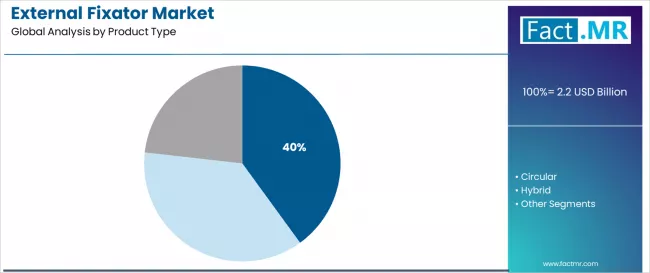
Market Position: Unilateral external fixators command the leading position in the external fixator market with 40% market share through advanced stabilization features, including superior fixation strength, operational efficiency, and orthopedic treatment optimization that enable surgical facilities to achieve optimal bone healing outcomes across diverse trauma and orthopedic environments.
Value Drivers: The segment benefits from orthopedic surgeon preference for reliable fixation systems that provide consistent stabilization performance, reduced surgical complexity, and treatment effectiveness optimization without requiring significant infrastructure modifications. Advanced design features enable precise pin placement, adjustable compression, and integration with existing orthopedic equipment, where fixation performance and patient comfort represent critical treatment requirements.
Competitive Advantages: Unilateral external fixators systems differentiate through proven clinical reliability, consistent stabilization characteristics, and integration with advanced orthopedic systems that enhance treatment effectiveness while maintaining optimal healing standards suitable for diverse trauma and orthopedic applications.
Key market characteristics:
- Advanced fixation designs with optimized pin configuration and stabilization efficiency capabilities
- Enhanced treatment effectiveness, enabling 95-98% fixation stability with consistent healing outcomes
- Surgical compatibility, including automated placement systems, monitoring integration, and treatment optimization for orthopedic operations
Circular External Fixators Show Comprehensive Growth
Circular external fixators maintain a 35% market position in the external fixator market due to their comprehensive stabilization properties and complex deformity correction advantages. These systems appeal to facilities requiring advanced bone reconstruction with multi-directional stability for complex orthopedic applications. Market growth is driven by orthopedic expansion, emphasizing reliable fixation solutions and treatment effectiveness through optimized circular designs.
Hybrid External Fixators Demonstrate Specialized Growth
Hybrid external fixators capture 25% market share through specialized fixation requirements in complex trauma cases, deformity correction, and advanced orthopedic applications. These facilities demand versatile fixation systems capable of handling diverse bone conditions while providing effective stabilization capabilities and surgical flexibility.
By End Use, the Hospital Segment Shows Fastest Growth
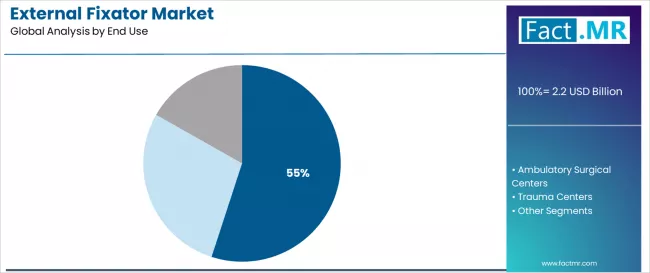
Market Context: Hospital applications demonstrate the highest growth rate in the external fixator market, capturing a share of 55%, due to widespread adoption of advanced fixation systems and increasing focus on trauma care optimization, surgical efficiency, and patient outcome applications that maximize treatment success while maintaining care standards.
Appeal Factors: Hospital operators prioritize system versatility, surgical efficiency, and integration with existing orthopedic infrastructure that enables coordinated treatment operations across multiple surgical specialties. The segment benefits from substantial healthcare investment and modernization programs that emphasize the acquisition of advanced fixation systems for treatment optimization and surgical excellence applications.
Growth Drivers: Healthcare expansion programs incorporate external fixators as standard equipment for trauma operations, while orthopedic service growth increases demand for comprehensive fixation capabilities that comply with treatment standards and minimize surgical complexity.
Market Challenges: Varying surgical requirements and technique complexity may limit system standardization across different hospitals or surgical scenarios.
Application dynamics include:
- Strong growth in trauma care and orthopedic surgery requiring advanced fixation capabilities
- Increasing adoption in treatment optimization and surgical efficiency applications for healthcare providers
- Rising integration with digital planning systems for surgical optimization and outcome tracking
Ambulatory Surgical Centers Maintain Specialized Demand
Ambulatory applications capture market share through specialized fixation requirements in outpatient procedures, minor trauma cases, and day surgery applications. These facilities demand efficient fixation systems capable of operating with simplified procedures while providing effective stabilization access and operational reliability capabilities.
Trauma Centers Show Emergency Leadership
Trauma center applications account for market share, including emergency orthopedics, critical fracture treatment, and urgent stabilization requiring immediate fixation capabilities for treatment optimization and emergency care.
What are the Drivers, Restraints, and Key Trends of the External Fixator Market?
| Category | Factor | Impact | Why It Matters |
|---|---|---|---|
| Driver | Rising trauma cases & sports injuries (aging population, active lifestyles) | ★★★★★ | Increasing injury rates create consistent demand for fixation devices with effective stabilization and bone healing across trauma applications. |
| Driver | Advanced surgical techniques & minimally invasive procedures | ★★★★★ | Transforms precision fixation from "standard" to "essential"; providers offering advanced systems and surgical integration gain competitive advantage. |
| Driver | Healthcare infrastructure expansion & specialized trauma centers | ★★★★☆ | Trauma centers need comprehensive fixation capabilities; demand for versatile, high-performance systems expanding addressable market. |
| Restraint | High equipment costs & training requirements | ★★★★☆ | Smaller hospitals defer purchases; increases cost sensitivity and slows advanced fixator adoption in resource-limited settings. |
| Restraint | Complex surgical procedures & learning curves | ★★★☆☆ | Advanced systems require specialized training and experience, limiting adoption speed and increasing implementation complexity. |
| Trend | Digital surgery integration & computer-assisted planning | ★★★★★ | Real-time surgical guidance, treatment planning, and outcome tracking transform operations; connectivity and digital features become core value propositions. |
| Trend | Personalized treatment & patient-specific solutions | ★★★★☆ | Custom fixation designs for individual patients; 3D printing technology and personalized implants drive competition toward customization solutions. |
Analysis of the External Fixator Market by Key Country
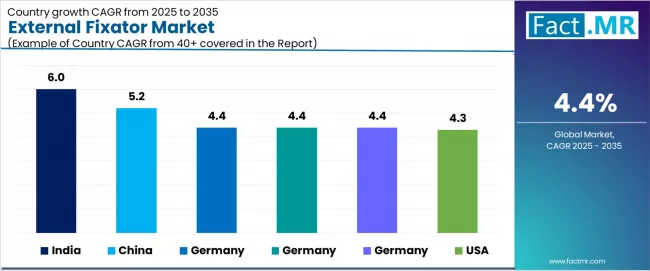
The external fixator market demonstrates varied regional dynamics with Growth Leaders including India (6.0% growth rate) and China (5.2% growth rate) driving expansion through healthcare infrastructure development and trauma care enhancement initiatives. Steady Performers encompass United States (4.3% growth rate), Germany (4.4% growth rate), and developed regions, benefiting from established orthopedic systems and advanced surgical adoption. Emerging Markets feature Brazil (4.4% growth rate) and developing regions, where healthcare initiatives and orthopedic modernization support consistent growth patterns.
Regional synthesis reveals Asian markets leading adoption through healthcare expansion and trauma care development, while North American countries maintain steady expansion supported by orthopedic technology advancement and surgical standardization requirements. European markets show moderate growth driven by orthopedic applications and treatment integration trends.
| Region/Country | 2025-2035 Growth | How to win | What to watch out |
|---|---|---|---|
| India | 6.0% | Focus on cost-effective fixation solutions | Healthcare infrastructure gaps; training requirements |
| China | 5.2% | Lead with advanced surgical systems | Regulatory compliance; local competition |
| United States | 4.3% | Provide comprehensive training support | Reimbursement pressures; surgeon preferences |
| Germany | 4.4% | Offer premium precision systems | Over-engineering; lengthy approval processes |
| Brazil | 4.4% | Value-oriented treatment models | Import duties; healthcare access |
| Europe | 4.4% | Push digital integration | Regulatory complexity; market fragmentation |
India Drives Fastest Market Growth
India establishes fastest market growth through aggressive healthcare infrastructure programs and comprehensive trauma care development, integrating advanced external fixators as standard components in orthopedic surgery and trauma treatment installations. The country's 6.0% growth rate reflects government initiatives promoting healthcare modernization and surgical capability development that mandate the use of advanced fixation systems in healthcare and trauma facilities. Growth concentrates in major healthcare centers, including Delhi, Mumbai, and Chennai, where orthopedic technology development showcases integrated fixation systems that appeal to surgeons seeking advanced treatment optimization capabilities and patient outcome applications.
Indian manufacturers are developing cost-effective fixation solutions that combine domestic production advantages with advanced surgical features, including precision placement systems and enhanced stability capabilities. Distribution channels through medical equipment suppliers and surgical service distributors expand market access, while government support for healthcare development supports adoption across diverse orthopedic and trauma segments.
Strategic Market Indicators:
- Healthcare facilities leading adoption with 74% deployment rate in orthopedic surgery and trauma treatment sectors
- Government healthcare programs providing substantial funding for domestic medical technology development
- Local manufacturers capturing 35% market share through competitive pricing and localized technical support
- Export market development for cost-effective fixation solutions targeting emerging healthcare markets
China Emerges as High-Growth Market
In Beijing, Shanghai, and Guangzhou, healthcare facilities and orthopedic centers are implementing advanced external fixators as standard equipment for trauma treatment and bone stabilization applications, driven by increasing government healthcare investment and medical modernization programs that emphasize the importance of surgical precision. The market holds a 5.2% growth rate, supported by government healthcare initiatives and orthopedic infrastructure development programs that promote advanced fixation systems for healthcare and trauma facilities. Chinese operators are adopting fixation systems that provide consistent surgical performance and treatment monitoring features, particularly appealing in urban regions where surgical efficiency and treatment standards represent critical operational requirements.
Market expansion benefits from growing orthopedic capabilities and international technology partnerships that enable domestic production of advanced fixation systems for healthcare and trauma applications. Technology adoption follows patterns established in medical equipment, where reliability and performance drive procurement decisions and surgical deployment.
Market Intelligence Brief:
- Healthcare and trauma segments are driving initial adoption with 48% annual growth in equipment procurement
- Medical modernization programs emphasizing fixation systems for surgical efficiency and patient outcomes
- Local manufacturers partnering with international providers for system development
- Healthcare facilities implementing fixation systems for treatment optimization and surgical excellence
United States Maintains Market Leadership
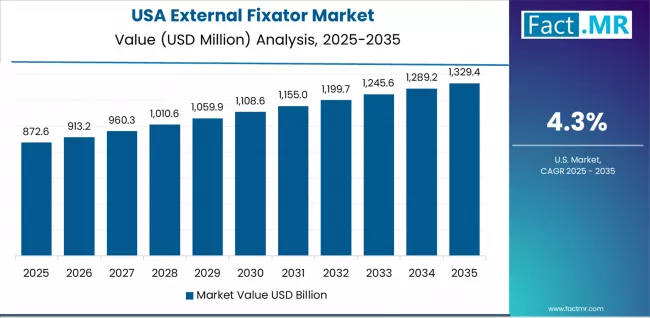
United States establishes market leadership through comprehensive orthopedic programs and advanced surgical infrastructure development, integrating external fixators across healthcare and trauma applications. The country's 4.3% growth rate reflects established orthopedic industry relationships and mature fixation technology adoption that supports widespread use of advanced stabilization systems in healthcare and surgical facilities. Growth concentrates in major medical centers, including California, Texas, and New York, where orthopedic technology showcases mature fixation deployment that appeals to surgeons seeking proven stabilization capabilities and operational efficiency applications.
American equipment providers leverage established distribution networks and comprehensive service capabilities, including surgical training programs and technical support that create customer relationships and operational advantages. The market benefits from mature regulatory standards and surgical requirements that mandate fixation system use while supporting technology advancement and treatment optimization.
Market Intelligence Brief:
- Healthcare and trauma facilities maintaining 86% adoption rate with mature fixation deployment
- Established regulatory standards providing consistent demand for fixation technology advancement
- Orthopedic networks capturing 72% market share through surgical expertise and treatment effectiveness
- Technology integration programs expanding fixation capabilities in surgical scenarios
Germany Shows Technology Leadership
Germany's advanced medical technology market demonstrates sophisticated external fixator deployment with documented treatment effectiveness in orthopedic applications and surgical facilities through integration with existing healthcare systems and surgical infrastructure. The country leverages engineering expertise in medical technology and surgical systems integration to maintain a 4.4% growth rate. Medical centers, including Bavaria, North Rhine-Westphalia, and Baden-Württemberg, showcase premium installations where fixation systems integrate with comprehensive orthopedic platforms and surgical management systems to optimize treatment operations and patient effectiveness.
German manufacturers prioritize system precision and EU compliance in fixation equipment development, creating demand for premium systems with advanced features, including surgical monitoring integration and automated stabilization systems. The market benefits from established medical technology infrastructure and a willingness to invest in advanced orthopedic technologies that provide long-term treatment benefits and compliance with international surgical standards.
Market Intelligence Brief:
- Engineering focuses on EU standardization and surgical safety compliance, driving premium segment growth
- Medical technology partnerships providing 24% faster development cycles
- Technology collaboration between German manufacturers and international orthopedic companies
- Facility training programs expanding fixation system integration in surgical scenarios
Brazil Shows Strong Regional Leadership
Brazil's market expansion benefits from diverse healthcare demand, including medical modernization in São Paulo and Rio de Janeiro, orthopedic facility upgrades, and government healthcare programs that increasingly incorporate fixation solutions for trauma treatment applications. The country maintains a 4.4% growth rate, driven by rising orthopedic activity and increasing recognition of fixation technology benefits, including effective bone stabilization and enhanced surgical outcomes.
Market dynamics focus on cost-effective fixation solutions that balance advanced surgical performance with affordability considerations important to Brazilian healthcare operators. Growing healthcare industrialization creates continued demand for modern fixation systems in new facility infrastructure and medical modernization projects.
Strategic Market Considerations:
- Healthcare and trauma segments leading growth with focus on treatment optimization and surgical excellence applications
- Regional healthcare requirements driving a diverse product portfolio from basic fixation equipment to advanced systems
- Import dependency challenges offset by potential local production partnerships with international manufacturers
- Government healthcare initiatives beginning to influence procurement standards and surgical requirements
Europe Market Split by Country
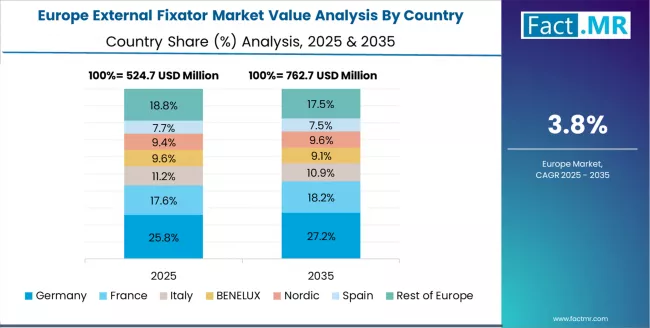
The European external fixator market is projected to grow from USD 1.8 billion in 2025 to USD 2.8 billion by 2035, registering a CAGR of 4.4% over the forecast period. Germany is expected to maintain its leadership position with a 21.1% market share in 2025, supported by advanced orthopedic technology infrastructure and major surgical centers.
France follows with a 17.8% share, driven by comprehensive orthopedic programs and surgical technology development initiatives. The United Kingdom holds a 15.6% share through specialized trauma applications and surgical excellence requirements. Italy commands a 13.9% share, while Spain accounts for 12.2% in 2025.
The rest of Europe region is anticipated to gain momentum, expanding its collective share from 19.4% in 2025 to 19.8% by 2035, attributed to increasing orthopedic adoption in Nordic countries and emerging surgical facilities implementing healthcare modernization programs.
Competitive Landscape of the External Fixator Market
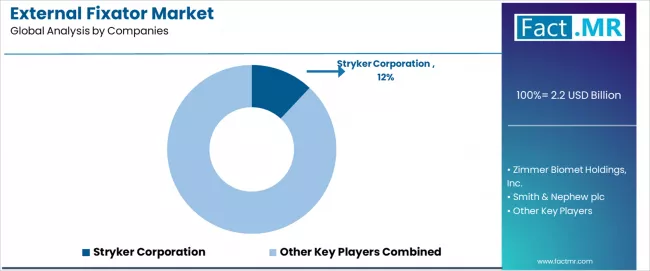
- Structure: ~10-15 credible players; top 3-5 hold ~65-70% by revenue.
- Leadership is maintained through: surgical training networks, clinical evidence, and technology innovation (precision + ease of use + digital integration).
- What's commoditizing: basic fixation mechanisms and standard surgical instruments.
- Margin Opportunities: surgical training services, component availability, and integration into surgical workflows (planning software, digital surgical records).
| Stakeholder | What they actually control | Typical strengths | Typical blind spots |
|---|---|---|---|
| Global platforms | Distribution reach, comprehensive product portfolios, training networks | Broad availability, proven surgical effectiveness, multi-region support | Technology refresh cycles; surgeon loyalty dependency |
| Technology innovators | R&D capabilities; smart fixation systems; clean digital interfaces | Latest features first; attractive ROI on surgical outcomes | Training density outside core regions; customization complexity |
| Regional specialists | Local surgical compliance, fast delivery, nearby technical support | "Close to surgeon" support; pragmatic pricing; local regulations | Technology gaps; talent retention in service |
| Service-focused ecosystems | Training programs, surgical support, component availability | Lowest surgical complications; comprehensive surgeon support | Service costs if overpromised; technology obsolescence |
| Orthopedic specialists | Trauma applications, specialized procedures, research collaboration | Win complex trauma cases; flexible surgical solutions | Scalability limitations; narrow market focus |
Key Players in the External Fixator Market
- Stryker Corporation
- Zimmer Biomet Holdings Inc.
- Smith & Nephew plc
- Orthofix Medical Inc.
- Johnson & Johnson DePuy Synthes
- Medtronic plc
- Globus Medical Inc.
- Acumed LLC
- Wuhu Tongye Medical Equipment Co., Ltd.
- Double Medical Technology Inc.
- Wishbone Medical Inc.
- Ortho SUV Ltd.
- Response Ortho Ltd.
- Jeil Medical Corporation
- Orthopaedic Fixator Systems Ltd.
Scope of the Report
| Items | Values |
|---|---|
| Quantitative Units (2025) | USD 2.2 billion |
| Product Type | Unilateral, Circular, Hybrid |
| End Use | Hospitals, Ambulatory Surgical Centers, Trauma Centers |
| Regions Covered | North America, Latin America, Western Europe, Eastern Europe, East Asia, South Asia Pacific, Middle East & Africa |
| Countries Covered | United States, China, Germany, India, United Kingdom, Japan, Canada, Brazil, France, Australia, and 25+ additional countries |
| Key Companies Profiled | Stryker, Zimmer Biomet, Smith & Nephew, Orthofix, Johnson & Johnson DePuy Synthes, Medtronic, Globus Medical, Acumed, Wuhu Tongye, Double Medical |
| Additional Attributes | Dollar sales by product type and end-user categories, regional adoption trends across North America, East Asia, and Western Europe, competitive landscape with orthopedic device manufacturers and surgical equipment suppliers, surgeon preferences for fixation precision control and system reliability, integration with surgical platforms and planning systems, innovations in fixation technology and surgical enhancement, and development of digital fixation solutions with enhanced performance and orthopedic optimization capabilities. |
External Fixator Market by Segments
-
Product Type :
- Unilateral
- Circular
- Hybrid
-
End Use :
- Hospitals
- Ambulatory Surgical Centers
- Trauma Centers
-
Region :
- North America
- United States
- Canada
- Mexico
- Latin America
- Brazil
- Chile
- Rest of Latin America
- Western Europe
- Germany
- United Kingdom
- France
- Italy
- Spain
- Nordic
- BENELUX
- Rest of Western Europe
- Eastern Europe
- Russia
- Poland
- Rest of Eastern Europe
- East Asia
- China
- Japan
- South Korea
- South Asia Pacific
- India
- ASEAN
- Australia & New Zealand
- Rest of South Asia Pacific
- Middle East & Africa
- Kingdom of Saudi Arabia
- Other GCC Countries
- Turkey
- South Africa
- Other African Union
- Rest of Middle East & Africa
- North America
Table of Content
- Executive Summary
- Global Market Outlook
- Demand to side Trends
- Supply to side Trends
- Technology Roadmap Analysis
- Analysis and Recommendations
- Market Overview
- Market Coverage / Taxonomy
- Market Definition / Scope / Limitations
- Market Background
- Market Dynamics
- Drivers
- Restraints
- Opportunity
- Trends
- Scenario Forecast
- Demand in Optimistic Scenario
- Demand in Likely Scenario
- Demand in Conservative Scenario
- Opportunity Map Analysis
- Product Life Cycle Analysis
- Supply Chain Analysis
- Investment Feasibility Matrix
- Value Chain Analysis
- PESTLE and Porter’s Analysis
- Regulatory Landscape
- Regional Parent Market Outlook
- Production and Consumption Statistics
- Import and Export Statistics
- Market Dynamics
- Global Market Analysis 2020 to 2024 and Forecast, 2025 to 2035
- Historical Market Size Value (USD Million) Analysis, 2020 to 2024
- Current and Future Market Size Value (USD Million) Projections, 2025 to 2035
- Y to o to Y Growth Trend Analysis
- Absolute $ Opportunity Analysis
- Global Market Pricing Analysis 2020 to 2024 and Forecast 2025 to 2035
- Global Market Analysis 2020 to 2024 and Forecast 2025 to 2035, By Product Type
- Introduction / Key Findings
- Historical Market Size Value (USD Million) Analysis By Product Type , 2020 to 2024
- Current and Future Market Size Value (USD Million) Analysis and Forecast By Product Type , 2025 to 2035
- Unilateral
- Circular
- Hybrid
- Y to o to Y Growth Trend Analysis By Product Type , 2020 to 2024
- Absolute $ Opportunity Analysis By Product Type , 2025 to 2035
- Global Market Analysis 2020 to 2024 and Forecast 2025 to 2035, By End Use
- Introduction / Key Findings
- Historical Market Size Value (USD Million) Analysis By End Use, 2020 to 2024
- Current and Future Market Size Value (USD Million) Analysis and Forecast By End Use, 2025 to 2035
- Hospitals
- Ambulatory Surgical Centers
- Trauma Centers
- Y to o to Y Growth Trend Analysis By End Use, 2020 to 2024
- Absolute $ Opportunity Analysis By End Use, 2025 to 2035
- Global Market Analysis 2020 to 2024 and Forecast 2025 to 2035, By Region
- Introduction
- Historical Market Size Value (USD Million) Analysis By Region, 2020 to 2024
- Current Market Size Value (USD Million) Analysis and Forecast By Region, 2025 to 2035
- North America
- Latin America
- Western Europe
- Eastern Europe
- East Asia
- South Asia and Pacific
- Middle East & Africa
- Market Attractiveness Analysis By Region
- North America Market Analysis 2020 to 2024 and Forecast 2025 to 2035, By Country
- Historical Market Size Value (USD Million) Trend Analysis By Market Taxonomy, 2020 to 2024
- Market Size Value (USD Million) Forecast By Market Taxonomy, 2025 to 2035
- By Country
- USA
- Canada
- Mexico
- By Product Type
- By End Use
- By Country
- Market Attractiveness Analysis
- By Country
- By Product Type
- By End Use
- Key Takeaways
- Latin America Market Analysis 2020 to 2024 and Forecast 2025 to 2035, By Country
- Historical Market Size Value (USD Million) Trend Analysis By Market Taxonomy, 2020 to 2024
- Market Size Value (USD Million) Forecast By Market Taxonomy, 2025 to 2035
- By Country
- Brazil
- Chile
- Rest of Latin America
- By Product Type
- By End Use
- By Country
- Market Attractiveness Analysis
- By Country
- By Product Type
- By End Use
- Key Takeaways
- Western Europe Market Analysis 2020 to 2024 and Forecast 2025 to 2035, By Country
- Historical Market Size Value (USD Million) Trend Analysis By Market Taxonomy, 2020 to 2024
- Market Size Value (USD Million) Forecast By Market Taxonomy, 2025 to 2035
- By Country
- Germany
- UK
- Italy
- Spain
- France
- Nordic
- BENELUX
- Rest of Western Europe
- By Product Type
- By End Use
- By Country
- Market Attractiveness Analysis
- By Country
- By Product Type
- By End Use
- Key Takeaways
- Eastern Europe Market Analysis 2020 to 2024 and Forecast 2025 to 2035, By Country
- Historical Market Size Value (USD Million) Trend Analysis By Market Taxonomy, 2020 to 2024
- Market Size Value (USD Million) Forecast By Market Taxonomy, 2025 to 2035
- By Country
- Russia
- Poland
- Hungary
- Balkan & Baltic
- Rest of Eastern Europe
- By Product Type
- By End Use
- By Country
- Market Attractiveness Analysis
- By Country
- By Product Type
- By End Use
- Key Takeaways
- East Asia Market Analysis 2020 to 2024 and Forecast 2025 to 2035, By Country
- Historical Market Size Value (USD Million) Trend Analysis By Market Taxonomy, 2020 to 2024
- Market Size Value (USD Million) Forecast By Market Taxonomy, 2025 to 2035
- By Country
- China
- Japan
- South Korea
- By Product Type
- By End Use
- By Country
- Market Attractiveness Analysis
- By Country
- By Product Type
- By End Use
- Key Takeaways
- South Asia and Pacific Market Analysis 2020 to 2024 and Forecast 2025 to 2035, By Country
- Historical Market Size Value (USD Million) Trend Analysis By Market Taxonomy, 2020 to 2024
- Market Size Value (USD Million) Forecast By Market Taxonomy, 2025 to 2035
- By Country
- India
- ASEAN
- Australia & New Zealand
- Rest of South Asia and Pacific
- By Product Type
- By End Use
- By Country
- Market Attractiveness Analysis
- By Country
- By Product Type
- By End Use
- Key Takeaways
- Middle East & Africa Market Analysis 2020 to 2024 and Forecast 2025 to 2035, By Country
- Historical Market Size Value (USD Million) Trend Analysis By Market Taxonomy, 2020 to 2024
- Market Size Value (USD Million) Forecast By Market Taxonomy, 2025 to 2035
- By Country
- Kingdom of Saudi Arabia
- Other GCC Countries
- Turkiye
- South Africa
- Other African Union
- Rest of Middle East & Africa
- By Product Type
- By End Use
- By Country
- Market Attractiveness Analysis
- By Country
- By Product Type
- By End Use
- Key Takeaways
- Key Countries Market Analysis
- USA
- Pricing Analysis
- Market Share Analysis, 2024
- By Product Type
- By End Use
- Canada
- Pricing Analysis
- Market Share Analysis, 2024
- By Product Type
- By End Use
- Mexico
- Pricing Analysis
- Market Share Analysis, 2024
- By Product Type
- By End Use
- Brazil
- Pricing Analysis
- Market Share Analysis, 2024
- By Product Type
- By End Use
- Chile
- Pricing Analysis
- Market Share Analysis, 2024
- By Product Type
- By End Use
- Germany
- Pricing Analysis
- Market Share Analysis, 2024
- By Product Type
- By End Use
- UK
- Pricing Analysis
- Market Share Analysis, 2024
- By Product Type
- By End Use
- Italy
- Pricing Analysis
- Market Share Analysis, 2024
- By Product Type
- By End Use
- Spain
- Pricing Analysis
- Market Share Analysis, 2024
- By Product Type
- By End Use
- France
- Pricing Analysis
- Market Share Analysis, 2024
- By Product Type
- By End Use
- India
- Pricing Analysis
- Market Share Analysis, 2024
- By Product Type
- By End Use
- ASEAN
- Pricing Analysis
- Market Share Analysis, 2024
- By Product Type
- By End Use
- Australia & New Zealand
- Pricing Analysis
- Market Share Analysis, 2024
- By Product Type
- By End Use
- China
- Pricing Analysis
- Market Share Analysis, 2024
- By Product Type
- By End Use
- Japan
- Pricing Analysis
- Market Share Analysis, 2024
- By Product Type
- By End Use
- South Korea
- Pricing Analysis
- Market Share Analysis, 2024
- By Product Type
- By End Use
- Russia
- Pricing Analysis
- Market Share Analysis, 2024
- By Product Type
- By End Use
- Poland
- Pricing Analysis
- Market Share Analysis, 2024
- By Product Type
- By End Use
- Hungary
- Pricing Analysis
- Market Share Analysis, 2024
- By Product Type
- By End Use
- Kingdom of Saudi Arabia
- Pricing Analysis
- Market Share Analysis, 2024
- By Product Type
- By End Use
- Turkiye
- Pricing Analysis
- Market Share Analysis, 2024
- By Product Type
- By End Use
- South Africa
- Pricing Analysis
- Market Share Analysis, 2024
- By Product Type
- By End Use
- USA
- Market Structure Analysis
- Competition Dashboard
- Competition Benchmarking
- Market Share Analysis of Top Players
- By Regional
- By Product Type
- By End Use
- Competition Analysis
- Competition Deep Dive
- Stryker Corporation
- Overview
- Product Portfolio
- Profitability by Market Segments (Product/Age /Sales Channel/Region)
- Sales Footprint
- Strategy Overview
- Marketing Strategy
- Product Strategy
- Channel Strategy
- Zimmer Biomet Holdings, Inc.
- Smith & Nephew plc
- Orthofix Medical Inc.
- Johnson & Johnson / DePuy Synthes
- Medtronic plc
- Globus Medical Inc.
- Acumed LLC
- Wuhu Tongye Medical Equipment Co., Ltd.
- Double Medical Technology Inc.
- Wishbone Medical Inc.
- Ortho SUV Ltd.
- Response Ortho Ltd.
- Jeil Medical Corporation
- Orthopaedic Fixator Systems Ltd.
- Stryker Corporation
- Competition Deep Dive
- Assumptions & Acronyms Used
- Research Methodology
List Of Table
- Table 1: Global Market Value (USD Million) Forecast by Region, 2020 to 2035
- Table 2: Global Market Value (USD Million) Forecast by Product Type , 2020 to 2035
- Table 3: Global Market Value (USD Million) Forecast by End Use, 2020 to 2035
- Table 4: North America Market Value (USD Million) Forecast by Country, 2020 to 2035
- Table 5: North America Market Value (USD Million) Forecast by Product Type , 2020 to 2035
- Table 6: North America Market Value (USD Million) Forecast by End Use, 2020 to 2035
- Table 7: Latin America Market Value (USD Million) Forecast by Country, 2020 to 2035
- Table 8: Latin America Market Value (USD Million) Forecast by Product Type , 2020 to 2035
- Table 9: Latin America Market Value (USD Million) Forecast by End Use, 2020 to 2035
- Table 10: Western Europe Market Value (USD Million) Forecast by Country, 2020 to 2035
- Table 11: Western Europe Market Value (USD Million) Forecast by Product Type , 2020 to 2035
- Table 12: Western Europe Market Value (USD Million) Forecast by End Use, 2020 to 2035
- Table 13: Eastern Europe Market Value (USD Million) Forecast by Country, 2020 to 2035
- Table 14: Eastern Europe Market Value (USD Million) Forecast by Product Type , 2020 to 2035
- Table 15: Eastern Europe Market Value (USD Million) Forecast by End Use, 2020 to 2035
- Table 16: East Asia Market Value (USD Million) Forecast by Country, 2020 to 2035
- Table 17: East Asia Market Value (USD Million) Forecast by Product Type , 2020 to 2035
- Table 18: East Asia Market Value (USD Million) Forecast by End Use, 2020 to 2035
- Table 19: South Asia and Pacific Market Value (USD Million) Forecast by Country, 2020 to 2035
- Table 20: South Asia and Pacific Market Value (USD Million) Forecast by Product Type , 2020 to 2035
- Table 21: South Asia and Pacific Market Value (USD Million) Forecast by End Use, 2020 to 2035
- Table 22: Middle East & Africa Market Value (USD Million) Forecast by Country, 2020 to 2035
- Table 23: Middle East & Africa Market Value (USD Million) Forecast by Product Type , 2020 to 2035
- Table 24: Middle East & Africa Market Value (USD Million) Forecast by End Use, 2020 to 2035
List Of Figures
- Figure 1: Global Market Pricing Analysis
- Figure 2: Global Market Value (USD Million) Forecast 2020-2035
- Figure 3: Global Market Value Share and BPS Analysis by Product Type , 2025 and 2035
- Figure 4: Global Market Y to o to Y Growth Comparison by Product Type , 2025-2035
- Figure 5: Global Market Attractiveness Analysis by Product Type
- Figure 6: Global Market Value Share and BPS Analysis by End Use, 2025 and 2035
- Figure 7: Global Market Y to o to Y Growth Comparison by End Use, 2025-2035
- Figure 8: Global Market Attractiveness Analysis by End Use
- Figure 9: Global Market Value (USD Million) Share and BPS Analysis by Region, 2025 and 2035
- Figure 10: Global Market Y to o to Y Growth Comparison by Region, 2025-2035
- Figure 11: Global Market Attractiveness Analysis by Region
- Figure 12: North America Market Incremental Dollar Opportunity, 2025-2035
- Figure 13: Latin America Market Incremental Dollar Opportunity, 2025-2035
- Figure 14: Western Europe Market Incremental Dollar Opportunity, 2025-2035
- Figure 15: Eastern Europe Market Incremental Dollar Opportunity, 2025-2035
- Figure 16: East Asia Market Incremental Dollar Opportunity, 2025-2035
- Figure 17: South Asia and Pacific Market Incremental Dollar Opportunity, 2025-2035
- Figure 18: Middle East & Africa Market Incremental Dollar Opportunity, 2025-2035
- Figure 19: North America Market Value Share and BPS Analysis by Country, 2025 and 2035
- Figure 20: North America Market Value Share and BPS Analysis by Product Type , 2025 and 2035
- Figure 21: North America Market Y to o to Y Growth Comparison by Product Type , 2025-2035
- Figure 22: North America Market Attractiveness Analysis by Product Type
- Figure 23: North America Market Value Share and BPS Analysis by End Use, 2025 and 2035
- Figure 24: North America Market Y to o to Y Growth Comparison by End Use, 2025-2035
- Figure 25: North America Market Attractiveness Analysis by End Use
- Figure 26: Latin America Market Value Share and BPS Analysis by Country, 2025 and 2035
- Figure 27: Latin America Market Value Share and BPS Analysis by Product Type , 2025 and 2035
- Figure 28: Latin America Market Y to o to Y Growth Comparison by Product Type , 2025-2035
- Figure 29: Latin America Market Attractiveness Analysis by Product Type
- Figure 30: Latin America Market Value Share and BPS Analysis by End Use, 2025 and 2035
- Figure 31: Latin America Market Y to o to Y Growth Comparison by End Use, 2025-2035
- Figure 32: Latin America Market Attractiveness Analysis by End Use
- Figure 33: Western Europe Market Value Share and BPS Analysis by Country, 2025 and 2035
- Figure 34: Western Europe Market Value Share and BPS Analysis by Product Type , 2025 and 2035
- Figure 35: Western Europe Market Y to o to Y Growth Comparison by Product Type , 2025-2035
- Figure 36: Western Europe Market Attractiveness Analysis by Product Type
- Figure 37: Western Europe Market Value Share and BPS Analysis by End Use, 2025 and 2035
- Figure 38: Western Europe Market Y to o to Y Growth Comparison by End Use, 2025-2035
- Figure 39: Western Europe Market Attractiveness Analysis by End Use
- Figure 40: Eastern Europe Market Value Share and BPS Analysis by Country, 2025 and 2035
- Figure 41: Eastern Europe Market Value Share and BPS Analysis by Product Type , 2025 and 2035
- Figure 42: Eastern Europe Market Y to o to Y Growth Comparison by Product Type , 2025-2035
- Figure 43: Eastern Europe Market Attractiveness Analysis by Product Type
- Figure 44: Eastern Europe Market Value Share and BPS Analysis by End Use, 2025 and 2035
- Figure 45: Eastern Europe Market Y to o to Y Growth Comparison by End Use, 2025-2035
- Figure 46: Eastern Europe Market Attractiveness Analysis by End Use
- Figure 47: East Asia Market Value Share and BPS Analysis by Country, 2025 and 2035
- Figure 48: East Asia Market Value Share and BPS Analysis by Product Type , 2025 and 2035
- Figure 49: East Asia Market Y to o to Y Growth Comparison by Product Type , 2025-2035
- Figure 50: East Asia Market Attractiveness Analysis by Product Type
- Figure 51: East Asia Market Value Share and BPS Analysis by End Use, 2025 and 2035
- Figure 52: East Asia Market Y to o to Y Growth Comparison by End Use, 2025-2035
- Figure 53: East Asia Market Attractiveness Analysis by End Use
- Figure 54: South Asia and Pacific Market Value Share and BPS Analysis by Country, 2025 and 2035
- Figure 55: South Asia and Pacific Market Value Share and BPS Analysis by Product Type , 2025 and 2035
- Figure 56: South Asia and Pacific Market Y to o to Y Growth Comparison by Product Type , 2025-2035
- Figure 57: South Asia and Pacific Market Attractiveness Analysis by Product Type
- Figure 58: South Asia and Pacific Market Value Share and BPS Analysis by End Use, 2025 and 2035
- Figure 59: South Asia and Pacific Market Y to o to Y Growth Comparison by End Use, 2025-2035
- Figure 60: South Asia and Pacific Market Attractiveness Analysis by End Use
- Figure 61: Middle East & Africa Market Value Share and BPS Analysis by Country, 2025 and 2035
- Figure 62: Middle East & Africa Market Value Share and BPS Analysis by Product Type , 2025 and 2035
- Figure 63: Middle East & Africa Market Y to o to Y Growth Comparison by Product Type , 2025-2035
- Figure 64: Middle East & Africa Market Attractiveness Analysis by Product Type
- Figure 65: Middle East & Africa Market Value Share and BPS Analysis by End Use, 2025 and 2035
- Figure 66: Middle East & Africa Market Y to o to Y Growth Comparison by End Use, 2025-2035
- Figure 67: Middle East & Africa Market Attractiveness Analysis by End Use
- Figure 68: Global Market - Tier Structure Analysis
- Figure 69: Global Market - Company Share Analysis
- FAQs -
How big is the external fixator market in 2025?
The global external fixator market is estimated to be valued at USD 2.2 billion in 2025.
What will be the size of external fixator market in 2035?
The market size for the external fixator market is projected to reach USD 3.4 billion by 2035.
How much will be the external fixator market growth between 2025 and 2035?
The external fixator market is expected to grow at a 4.4% CAGR between 2025 and 2035.
What are the key product types in the external fixator market?
The key product types in external fixator market are unilateral, circular and hybrid.
Which end use segment to contribute significant share in the external fixator market in 2025?
In terms of end use, hospitals segment to command 55.0% share in the external fixator market in 2025.